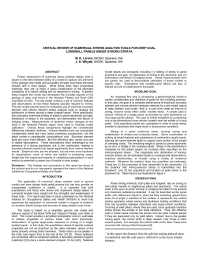Mining Publication: Critical Review of Numerical Stress Analysis Tools for Deep Coal Longwall Panels Under Strong Strata
Original creation date: February 2009
Proper employment of numerical stress analysis design tools is based on the demonstrated ability of a model to capture key elements of the geologic site model and accurately simulate how these elements interact with a mine design. While these tools have progressed markedly, they are, at heart, a gross simplification of the abundant complexity of a natural setting and its response to mining. A generic deep longwall site model was developed that includes aspects of the geology of deep coal mines in the Wasatch Plateau and Book Cliffs coal fields of Utah. The site model contains a set of common features and observations of how these features typically respond to mining. This site model was the basis for evaluating use of empirical, boundary element and volume element stress analysis tools to analyze the distribution of stress around a deep longwall panel. More specifically, this evaluation examined shifting of stress to panel abutments and gob, distribution of stress in the abutment, and deformation and failure of bridging strata. Measurements of abutment stress changes at two sites in the Wasatch Plateau region were used to illustrate model calibration. Overall, these comparisons highlight the considerable differences between methods. Volume element tools can incorporate considerable detail and have fewer underlying assumptions, but this detail carries a considerable computational cost. Boundary element tools are much more efficient. But this efficiency also comes at a cost of added assumptions. These assumptions were challenged by the presence of a strong sandstone unit in the overburden, leading to boundary element results that depart significantly from volume element results. Empirical rules are the simplest, but are even more burdened by assumptions, many of which are implicit in underlying cases. Insight into the nature and impacts of underlying assumptions in each method is essential to proper use of results in mine design.
Authors: MK Larson, JK Whyatt
Conference Paper - February 2009
NIOSHTIC2 Number: 20035607
2009 SME Annual Meeting and Exhibit, February 22-25, Denver, Colorado, preprint 09-011. Littleton, CO: Society for Mining, Metallurgy, and Exploration, Inc., 2009; :1-12
See Also
- Analysis and Prediction of Longwall Methane Emissions: A Case Study in the Pocahontas No. 3 Coalbed, VA
- Calibration and Verification of Longwall Stress Models
- Development of Multiple Regression Functions for Performance Prediction of Gob Gas Ventholes for Sealed and Active Longwall Mines
- Effect of Longwall Face Advance on Spontaneous Heating in Longwall Gob Areas
- Elastic and Shear Moduli of Coal Measure Rocks Derived from Basic Well Logs Using Fractal Statistics and Radial Basis Functions
- Numerical Model Calibration for Simulating Coal Pillars, Gob and Overburden Response
- Numerical Modeling Procedures for Practical Coal Mine Design
- The State-of-the-Art in Coal Pillar Design
- Stochastic Modeling of Gob Gas Venthole Production Performances in Active and Completed Longwall Panels of Coal Mines
- Technology News 493 - Proceedings: New Technology for Coal Mine Roof Support
- Page last reviewed: 9/21/2012
- Page last updated: 9/21/2012
- Content source: National Institute for Occupational Safety and Health, Mining Program


 ShareCompartir
ShareCompartir
